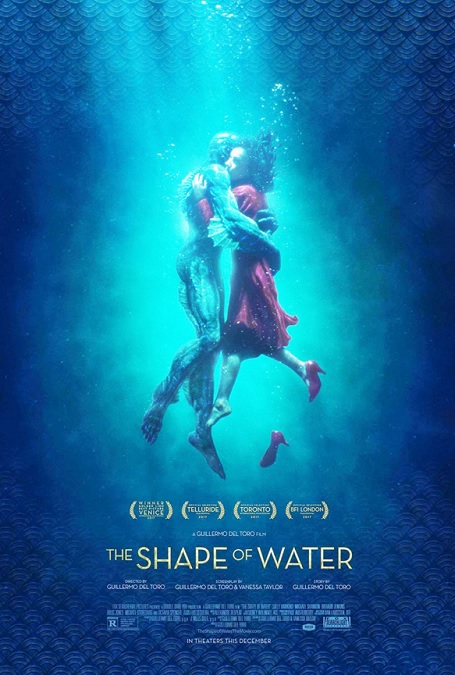
The Shape of Water 2018
I applaud the Academy for recognizing a fantasy film. It did so for its artfulness, its drama, its acting, its musical score, and most importantly, its directing. To be sure, I believe this movie could easily be called a work of art. It was part fairy tale, part monster movie, part romance, and part 1960s period drama dealing with the Cold War. It had a wonderful cast and a beautifully told and engaging story.
And all this, allegedly, came from the mind of the acclaimed director, Guillermo Del Toro, who has directed only twelve films over his career. Perhaps he is most famous for the dark horror fantasy, Pan’s Labyrinth, though he is no stranger to directing more main-stream Hollywood blockbusters like Blade II, Hellboy I and II, and Pacific Rim. Here, in The Shape of Water, Del Toro steps away from his normal horror and action genres and gives us a romance. But I think that because of his roots in dark fantasy, it was a romance in the theatre of the bizarre. But it worked, and it worked beautifully. Del Toro has a knack for making the strange and almost grotesque look magical and alluring.
The main story is about Elisa Esposito, played by Sally Hawkins, a mute cleaning lady working at a secret government laboratory. When a mysterious creature, referred to as “the asset”, is brought in, Elisa is intensely curious about it. She sees that the creature is kept in a dark dungeon-like place that looked like it was designed by H. R. Giger, shackled in chains. It is shaped like a man, but has all the qualities of a sea monster. Its face is just human enough to display recognizable emotion. Elisa is attracted to its other-worldly beauty.
Interesting Note: When Del Toro was in talks with Universal Studios about doing a remake of the classic monster movie, 1954’s The Creature From the Black Lagoon, he pitched a story in which the monster gets the girl. His idea was rejected, but Del Toro had the last laugh. The Shape of Water ended up making over $172 million at the box office.
Elisa goes out of her way to find out what the creature is, and learns that it is a humanoid amphibian, played by Doug Jones. It is never given a name. She feels immediate sympathy for the creature, seeing it as a poor tortured animal. But when she learns that it is intelligent, her feelings deepen to those of one who sees a fellow being suffering. She shows it kindness and develops an emotional bond with it. Eventually, that bond grows and grows until it manifests as romantic love.
I thought Sally Hawkins did a fantastic job. She had a strong meekness to make me feel sympathy for her, something I believe was essential for the character. But she also had enough maturity and fire to make me believe she would fight to have love and passion in her life. As I watched the interviews included on the DVD, the actress’s voice and speech patterns reflected a similar personality. She almost had what I sometimes call a “please don’t hit me” voice. You know, the kind of voice that makes a person sound inherently apologetic or afraid. And yet there was also a confidence that was undeniable. In other words, she was perfect for the part, and she did a great job. And yes, I think she really deserved her Best Actress nomination.
The government agent in charge of the creature is Colonel Richard Strickland, played by Michael Shannon. His commanding officer, General Frank Hoyt, played by Nick Searcy, is just as mean-spirited and domineering. Strickland already hates the creature because it is not human, but when it severs two of his fingers, his hate escalates into outright torture in which he uses a cattle prod. Here is where a strong theme in the movie was really given a lot of weight. The American government is evil and is run by evil men.
You see, the movie, according to Del Toro, is supposed to reflect the issues we are dealing with today without being blatant. Apparently, as he sees it, we live in a world in which governments are not to be trusted, and it is the freaks and the outcasts of society who turn out to be the most humane people of all. I’m not going to say whether this is true or not, but this isn’t the first movie to spout those sentiments.
When Strickland announces his plans to vivisect the creature, Elisa comes up with a plan to free him. At the same time, a Soviet spy posing as a lab scientist who cares for the creature as a rare and precious biological life-form, catches Elisa in her scheme. He decides to help her rather than let the creature be destroyed. Together, along with Elisa’s kindly neighbor and her sympathetic coworker, the creature is smuggled out of the lab and a plan is made to release it into the ocean.
The latter half of the film was all about Elisa’s love affair with the creature, and Strickland’s hunt for the escaped “asset.” The ending really cemented the plot as a real fairy tale, reversing the normal movie tropes and film stereotypes. The monster was the hero, the military man was the monster, and the damsel was transformed into a water breathing princess, allowing the two lovers to live happily ever after. It was sweet and a little unexpected.
But I have to mention one little scene that had me rolling my eyes just a little bit. At one point, as Elisa is hiding the creature in her bathroom, she goes in to make love to it. She stuffs towels under the door, turns on the bathtub and sink faucets, and fills the room with water. I’m just not sure about the logistics of that. I mean, the bathroom became filled almost to the ceiling with water. Yes, it was shown that water was spilling out all around the door and leaking through the floor, but really? The faucets would have to be pumping in more water than could escape from the room. I’m just not convinced that scene would have been realistically physically possible. But Ok, I get it. The movie is a fantasy. I’ll cut it a little slack.
Part of what propelled the movie from good to great is the well-written supporting characters. Each was given a distinct and realistic personality, making them all believable. They all seemed to be somehow damaged, each in their own ways. There was Elisa’s kindly neighbor, Giles, played by Richard Jenkins. He was a closeted homosexual, which was a dangerous thing in the 60s, causing him to have almost no self-confidence. There was Zelda Delilah Fuller, played by Octavia Spencer, Elisa’s fellow cleaning lady, and her interpreter at work. She was stuck in a marriage with a man who took lazy to a new level. And then there was Dimitri Mosenkov, played by Michael Stuhlbarg, the Russian spy working at the lab who wants to protect the unique creature from both the evil American military and his own Soviet superiors, though he is easily cowed in the face of authority.
I especially liked Octavia Spencer in her role as Elisa’s friend. Spencer is a very good actress and I always love watching her on the screen. She is always so real in her performances. I also liked Stuhlbarg. Ever since I noticed him in 2009’s Best Picture nominee, A Serious Man, I have been seeing him show up in unexpected places like 2011’s Hugo and 2012’s Lincoln, both of which were also nominated for the Best Picture. And Jenkins is a character actor who has been in a ton of films for over thirty years. He knows what he is doing.
Interesting note: Both Spencer and Jenkins were nominated for Oscars for their roles in this movie, and they were only two of its thirteen nominations. However, the four it won were Best Picture, Best Director for Del Toro, Best Original Score, and Best Production Design.
And it is that production design that stands out to me as the most memorable aspect of the film. The aesthetics, the visuals, the look of the movie. First lets talk about the obvious one: the creature. You might think that in a modern film, a movie monster who was so clearly not human would get a full CGI treatment. But to Del Toro’s credit, there was very little computer generated work done on him. It was a man in a rubber suit with small digital elements added for a greater sense of realism. I believe that the eyes and sometimes the spiny fin on its back were the most prominent added CGI effects. But it worked wonderfully! I thought the creature looked incredibly real and believable. In an age where CGI effects are so common, and are not always done well, I appreciate movies that try to keep them to a minimum. Of course, that being said, I don’t mind all the CGI in the world, as long as I don’t notice that it is being used.
Interesting note: Apparently, people thought the creature’s bioluminescent spots were added with lights inside the costume, but the interviews with Del Toro and the creature’s designers, Shane Mahan and Mike Hill, included on the DVD, said that it was simply black-light paint, which gave them the exact look they wanted.
Another trick used in the production design and the cinematography was the fact that most of the movie had a green tint to it, making me feel like it was all under water. And it wasn’t subtle. I immediately recognized the effect at the beginning of the film. But again, it was effective. It made certain colors like red and yellow stand out when they were used. And those colors were used in very specific ways. For example, when Elisa’s relationship with the creature became romantic, she started wearing red, indicating passion.
Now, I have to mention the little controversy surrounding the movie. You see, Del Toro claims that he thought of the concept for the film in 2011. However, in 2018, the estate of Paul Zindel initiated a lawsuit, in which he claims that Del Toro plagiarized from his 1969 play, Let Me Hear You Whisper. In this play, a cleaning woman bonds with a talking dolphin being abused in a secret research laboratory, and attempts to rescue it. Del Toro denies ever having any knowledge of the play before writing The Shape of Water. You have to admit that the similarities in the stories are remarkable, but I have no reason to call Del Toro a liar. He says that he thought of the concept during a conversation with the author Daniel Kraus, though Kraus never mentioned the play. You’ll all have to form your own opinions about that.
All in all, I thought The Shape of Water was a very good movie. Its romance and drama were smart and engaging, and yet passionate at the same time. The acting was excellent and the directing was incredible. The visuals were exciting and fanciful, inspiring my imagination. I love movies that are able to take me away from reality and show me things I can’t see in the real world. Sure, the concept was a little strange, but I applaud the academy for handing the Best Picture award to a fantasy film that truly defied my expectations.








